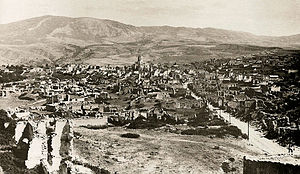Shusha pogrom
| Shusha massacre | |
|---|---|

Ruins of the Armenian half of Shusha after the city's destruction by Azerbaijani army in March 1920. In the center: defaced Armenian Ghazanchetsots Cathedral
|
|
| Location | Nagorno-Karabakh (disputed between Azerbaijan and Armenia) |
| Date | March 1920 |
| Target | Armenian civilians |
|
Attack type
|
Massacre,Riots, Pogrom |
| Deaths | 500-30,000 (estimated) |
The Shusha massacre (Armenian: Շուշիի ջարդեր – Shushii charder) was the mass killing of the Armenian population of Shusha and the destruction of the Armenian half of the city that followed the suppression of the Armenian revolt against the authorities of the Azerbaijan Democratic Republic in 1920.
The event took place between 22 and 26 March 1920, and had as its background a conflict over competing claims of ownership of the region by Armenia and Azerbaijan. It resulted in the complete destruction of the Armenian-populated quarters of Shusha and the elimination of the town's Armenian population.
At the end of the First World War, the ownership of the territory of Nagorno-Karabagh was disputed between the newly founded republics of Armenia and Azerbaijan. Shusha – the territory's largest settlement, its capital, and with a mixed population consisting mostly of ethnic Armenians (forming a majority) and Azeris – found themselves at the center of dispute.
The government of Azerbaijan proclaimed in Baku about the annexation of the disputed territory and, on January 15, 1919, appointed Khosrov bek Sultanov, the "owner of vast tracts of Karabagh ... an ardent pan-Turkist, a friend of the Ittihadists of Constantinople, and a terror to all Armenians", as governor-general of Karabagh. Britain (which had a small detachment of troops stationed in Shusha) agreed to Sultanov's appointment as a provisional governor, but insisted that a final decision on the territory's ownership should be decided only at a future Peace Conference.
...
Wikipedia
